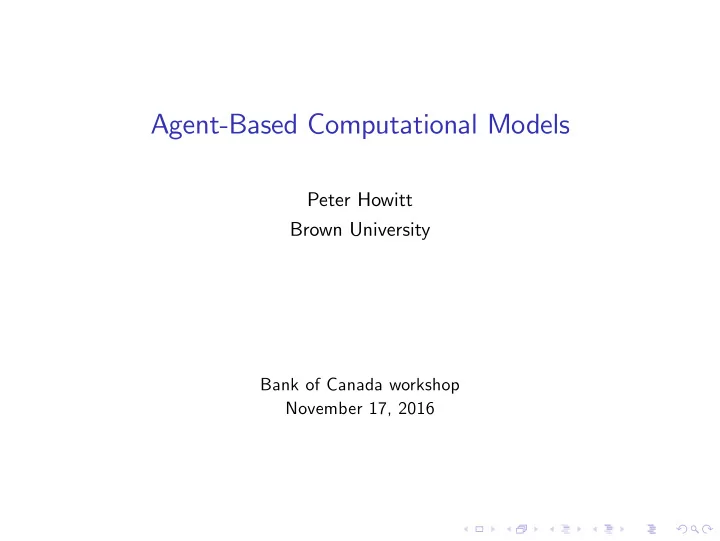

Agent-Based Computational Models Peter Howitt Brown University Bank of Canada workshop November 17, 2016
Agent-based computational economics Computational models of many interacting, heterogeneous agents, each endowed with simple behavioral rules permitting action in unknown complex environments, with no direct restrictions on aggregate outcomes.
Agent-based computational economics Computational models of many interacting, heterogeneous agents, each endowed with simple behavioral rules permitting action in unknown complex environments, with no direct restrictions on aggregate outcomes. Examples in economics: → Schelling’s segregation model (1969)
Agent-based computational economics Computational models of many interacting, heterogeneous agents, each endowed with simple behavioral rules permitting action in unknown complex environments, with no direct restrictions on aggregate outcomes. Examples in economics: → Schelling’s segregation model (1969) → Santa Fe Stock Market (1994)
Agent-based computational economics Computational models of many interacting, heterogeneous agents, each endowed with simple behavioral rules permitting action in unknown complex environments, with no direct restrictions on aggregate outcomes. Examples in economics: → Schelling’s segregation model (1969) → Santa Fe Stock Market (1994) → Geanakoplos et al. (AER 2012)
Agent-based computational economics Computational models of many interacting, heterogeneous agents, each endowed with simple behavioral rules permitting action in unknown complex environments, with no direct restrictions on aggregate outcomes. Examples in economics: → Schelling’s segregation model (1969) → Santa Fe Stock Market (1994) → Geanakoplos et al. (AER 2012) → The EURACE project
Agent-based computational economics Computational models of many interacting, heterogeneous agents, each endowed with simple behavioral rules permitting action in unknown complex environments, with no direct restrictions on aggregate outcomes. Examples in economics: → Schelling’s segregation model (1969) → Santa Fe Stock Market (1994) → Geanakoplos et al. (AER 2012) → The EURACE project → Dosi et al (Schumpeter meeting Keynes, 2010)
Agent-based computational economics Computational models of many interacting, heterogeneous agents, each endowed with simple behavioral rules permitting action in unknown complex environments, with no direct restrictions on aggregate outcomes. Examples in economics: → Schelling’s segregation model (1969) → Santa Fe Stock Market (1994) → Geanakoplos et al. (AER 2012) → The EURACE project → Dosi et al (Schumpeter meeting Keynes, 2010) → Ashraf, Gershman and Howitt (2016)
Agent-based computational economics Computational models of many interacting, heterogeneous agents, each endowed with simple behavioral rules permitting action in unknown complex environments, with no direct restrictions on aggregate outcomes. Examples in economics: → Schelling’s segregation model (1969) → Santa Fe Stock Market (1994) → Geanakoplos et al. (AER 2012) → The EURACE project → Dosi et al (Schumpeter meeting Keynes, 2010) → Ashraf, Gershman and Howitt (2016) → Tesfatsion-Judd Handbook of Computational Economics (2006)
Why in macroeconomics? Autonomy and spontaneous order
Where is the comparative advantage of ABM? 1. Costs of inflation
Where is the comparative advantage of ABM? 1. Costs of inflation 2. Systemic breakdown
Where is the comparative advantage of ABM? 1. Costs of inflation 2. Systemic breakdown 3. Big data
Where is the comparative advantage of ABM? 1. Costs of inflation 2. Systemic breakdown 3. Big data 4. Heterogeneity
Two methodological issues with ABMs 1. Can we retain discipline without imposing rationality and equilibrium?
Two methodological issues with ABMs 1. Can we retain discipline without imposing rationality and equilibrium? 2. What about the Lucas critique?
Conclusions 1. Central banks are well equipped for creating ABMs
Conclusions 1. Central banks are well equipped for creating ABMs 2. A central bank needs more than one model
Recommend
More recommend